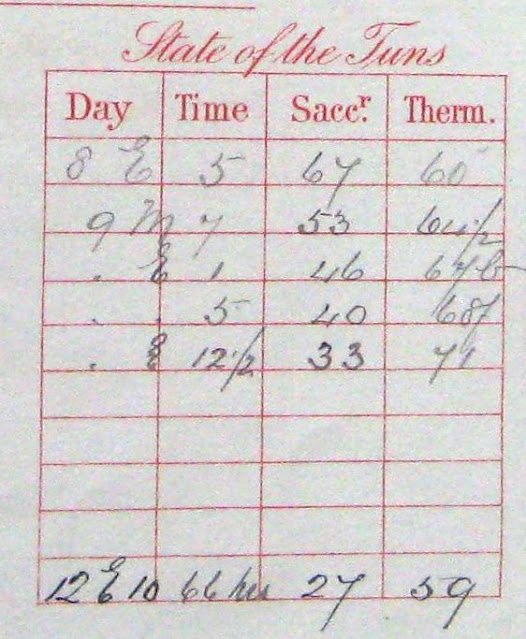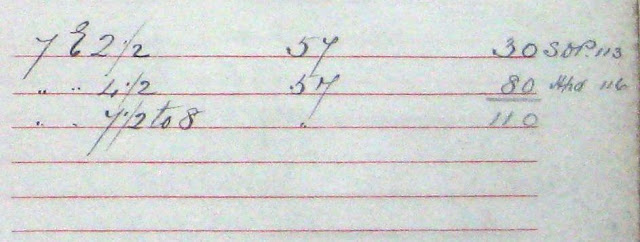We'll be finishing off this Barclay Perkins record today. With all things fermentation related.
First up are the gyling details.
Pretty simple this.
Column 1:
Volumes of the wort in barrels, firkins and gallons.
Column 2:
Gravity of the worts in SG. Obviously, with the 1000 missed off.
The three worts combined were 113 barrels, 2 firkins and 1 gallon at 1077º.
Fermentation record is next.
Column 1: Day
Day of the week
Column 2: Time
Time of day. "E" = PM, "M" = AM.
Column 3: Saccr.
"Saccharometer". The gravity in SG.
Column 4: Therm.
"Thermometer". The temperature in Fahrenheit.
Each row records a stage in the fermentation. It's not a full record, covering the first two days and then jumping to racking time. the beer was racked at 22:00 on 12th October with a gravity of 1027º and at 59º F.
Now onto yeast details.
Column 1:
Date and time pitched.
Column 2:
The temperature in Fahrenheit.
Column 3: yeast
lbs of yeast, beer it was harvested from, that beer's gyle number.
For example: 30lbs of yeast from SDP, gyle number 113.
Finally, one I'm not 100% sure about. I think it's details of when the beer was cleansed. That is, when is was moved from a round fermenter to pontos for the yeast to be removed.
First row:
Date and time; "ins." inches - distance from the brim of the vessel to the surface of the liquid; "Heat" the temperature of the wort in Fahrenheit.
Second row:
"Hrs." Time in hours between pitching and cleansing; "Sacc." gravity of the wort in SG.
That was fun. Anyone up for more punishment? I could run through what I call "Scottish format" brewing records. If anyone could be arsed enough to read it.














































































4 comments:
A very basic question here. This is one record for one batch and a very interesting explanation. When you mention going through the brewing records at the breweries do you see records for every batch they brewed during the time the records are still available? I have no concept of how many of these there are when you are reviewing them.
Bring it on. I could be arsed.
I get the sense this would be torture for you, but I'd be interested in seeing the same for a really old log and a fairly modern one to see what was different and what's changed.
Dave: yes, these are the actual logs that were needed for the brewery to keep track of how much beer they were making. Every brew every day is listed. Depending on the size of the brewery, there might be several brews a day.
Obviously this gets very repetitive. If I am photographing a log I tend to do one day a month, making sure I get all the main beers. Also if I notice them doing anything a bit unusual. That is generally enough.
Post a Comment